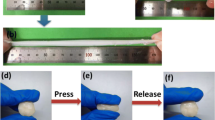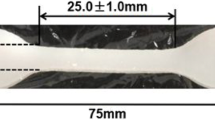Abstract
Hydrogels find a variety of uses across various fields, but their development might be limited by their high-cost, toxic chemical crosslinking and complicated reactions. To address these issues, we developed a tough, high-strength hydrogel of polydiacetone acrylamide-co-poly(acrylamide), prepared using acrylamide, diacetone acrylamide (DAAM) and ammonium persulfate in a one-step reaction. The multiple physical crosslinking networks endow hydrogel with excellent overall properties given appropriate DAAM levels. The tensile modulus, fractured strain, fractured stress and toughness of the developed D1A9 hydrogel are, respectively, as high as 0.15 MPa, 21 mm/mm, 0.71 MPa and 7 MJ/m2. Its compressive modulus under a strain of 80% is 0.088 MPa, while its shear modulus at a shear frequency of 100 Hz is 0.071 MPa. At the same time, D1A9 hydrogel exhibits a high self-recovery efficiency of 50% during two continuous cyclic tensile tests, with the efficiency increasing to 65% for hydrogel incubated at 50 °C for 2 h. Finally, cytocompatibility and excellent drug-releasing behavior of the hydrogel make it a candidate for biomedical use.
















Similar content being viewed by others
References
Sheng H, Wang X, Kong N et al (2019) Neural interfaces by hydrogels. Extreme Mech Lett 30:100510
Utech S, Boccaccini AR (2016) A review of hydrogel-based composites for biomedical applications: enhancement of hydrogel properties by addition of rigid inorganic fillers. J Mater Sci 51:271–310. https://doi.org/10.1007/s10853-015-9382-5
Wang Y, Chen F, Liu Z et al (2019) A highly elastic and reversibly stretchable all-polymer supercapacitor. Angew Chem Int Ed 58:15707–15711
Wei J, Wei G, Shang Y, Zhou J, Wu C, Wang Q (2019) Dissolution-crystallization transition within a polymer hydrogel for a processable ultratough electrolyte. Adv Mater 31:e1900248
Zhou X, Zhao F, Guo Y, Rosenberger B, Yu G (2019) Architecting highly hydratable polymer networks to tune the water state for solar water purification. Sci Adv 5:eaaw5484
Ji X, Li Z, Liu X et al (2019) A functioning macroscopic “Rubik’s Cube” assembled via controllable dynamic covalent interactions. Adv Mater 31:1902365
Gong M, Wan P, Ma D et al (2019) Flexible breathable nanomesh electronic devices for on-demand therapy. Adv Funct Mater 29:1902127
More SM, Kulkarni RV, Sa B, Kayane NV (2010) Glutaraldehyde-crosslinked poly(vinyl alcohol) hydrogel discs for the controlled release of antidiabetic drug. J Appl Polym Sci 116:1732–1738
Lu Z, Liu S, Le Y et al (2019) An injectable collagen–genipin–carbon dot hydrogel combined with photodynamic therapy to enhance chondrogenesis. Biomaterials 218:119190
Sasaki YF, Sekihashi K, Izumiyama F et al (2000) The comet assay with multiple mouse organs: comparison of comet assay results and carcinogenicity with 208 chemicals selected from the IARC monographs and USNTP carcinogenicity database. Crit Rev Toxicol 30:629–799
Jia YG, Jin J, Liu S, Ren L, Luo J, Zhu XX (2018) Self-healing hydrogels of low molecular weight poly(vinyl alcohol) assembled by host–guest recognition. Biomacromol 19:626–632
Chu CW, Ravoo BJ (2017) Hierarchical supramolecular hydrogels: self-assembly by peptides and photo-controlled release via host–guest interaction. Chem Commun 53:12450–12453
Liu C, Yang L, Qiao L, Liu C, Zhang M, Jian X (2019) An injectable and self-healing novel chitosan hydrogel with low adamantane substitution degree. Polym Int 68:1102–1112
Shi L, Ding P, Wang Y, Zhang Y, Ossipov D, Hilborn J (2019) Self-healing polymeric hydrogel formed by metal–ligand coordination assembly: design, fabrication, and biomedical applications. Macromol Rapid Comm 40:1800837
Guo M, Pitet LM, Wyss HM, Vos M, Dankers PYW, Meijer EW (2014) Tough stimuli-responsive supramolecular hydrogels with hydrogen-bonding network junctions. J Am Chem Soc 136:6969–6977
Meazza L, Foster JA, Fucke K, Metrangolo P, Resnati G, Steed JW (2013) Halogen-bonding-triggered supramolecular gel formation. Nat Chem 5:42–47
Qiao L, Liu C, Liu C et al (2019) Self-healing alginate hydrogel based on dynamic acylhydrazone and multiple hydrogen bonds. J Mater Sci 54:8814–8828. https://doi.org/10.1007/s10853-019-03483-y
Wang S, Liu M, Gao L, Guo G, Huo Y (2019) Optimized association of short alkyl side chains enables stiff, self-recoverable, and durable shape-memory hydrogel. ACS Appl Mater Interfaces 11:19554–19564
Tuncaboylu DC, Sari M, Oppermann W, Okay O (2011) Tough and self-healing hydrogels formed via hydrophobic interactions. Macromolecules 44:4997–5005
Bastings MMC, Koudstaal S, Kieltyka RE et al (2014) A fast pH-switchable and self-healing supramolecular hydrogel carrier for guided, local catheter injection in the infarcted myocardium. Adv Healthc Mater 3:70–78
Dankers PYW, van Luyn MJA, Huizinga-van A, der Vlag et al (2012) Development and in vivo characterization of supramolecular hydrogels for intrarenal drug delivery. Biomaterials 33:5144–5155
Cui J, del Campo A (2012) Multivalent H-bonds for self-healing hydrogels. Chem Commun 48:9302–9304
Gao F, Xu Z, Liang Q et al (2019) Osteochondral regeneration with 3D-printed biodegradable high-strength supramolecular polymer reinforced-gelatin hydrogel scaffolds. Adv Sci 6:1900867
Gan D, Xing W, Jiang L et al (2019) Plant-inspired adhesive and tough hydrogel based on Ag-Lignin nanoparticles-triggered dynamic redox catechol chemistry. Nat Commun 10. https://doi.org/10.1038/s41467-019-09351-2
Gaharwar AK, Peppas NA, Khademhosseini A (2014) Nanocomposite hydrogels for biomedical applications. Biotechnol Bioeng 111:441–453
Gao G, Wang Z, Xu D et al (2018) Snap-buckling motivated controllable jumping of thermo-responsive hydrogel bilayers. ACS Appl Mater Interfaces 10:41724–41731
Wu F, Chen L, Li Y, Lee KI, Fei B (2017) Super-tough hydrogels from shape-memory polyurethane with wide-adjustable mechanical properties. J Mater Sci 52:4421–4434. https://doi.org/10.1007/s10853-016-0689-7
Laux P, Riebeling C, Booth AM et al (2018) Challenges in characterizing the environmental fate and effects of carbon nanotubes and inorganic nanomaterials in aquatic systems. Environ Sci Nano 5:48–63
Xia S, Song S, Ren X, Gao G (2017) Highly tough, anti-fatigue and rapidly self-recoverable hydrogels reinforced with core–shell inorganic–organic hybrid latex particles. Soft Matter 13:6059–6067
Yang J, Deng L-H, Han C-R et al (2013) Synthetic and viscoelastic behaviors of silicananoparticle reinforced poly(acrylamide) core–shell nanocomposite hydrogels. Soft Matter 9:1220–1230
Sun TL, Kurokawa T, Kuroda S et al (2013) Physical hydrogels composed of polyampholytes demonstrate high toughness and viscoelasticity. Nat Mater 12:932–937
Bai R, Yang J, Suo Z (2019) Fatigue of hydrogels. Eur J Mech A Solids 74:337–370
Patyukova E, Rottreau T, Evans R, Topham PD, Greenall MJ (2018) Hydrogen bonding aggregation in acrylamide: theory and experiment. Macromolecules 51:7032–7043
McCormick CL, Chen GS (1984) Water-soluble copolymers. 9. Copolymers of acrylamide with N-(1,1-dimethyl-3-oxybutyl) acrylamide and N,N-dimethylacrylamide-synthesis and characterization. J Polym Sci A Polym Chem 22:3633–3647
Zhou W, Qu Q, Xu Y, An Z (2015) Aqueous polymerization-induced self-assembly for the synthesis of ketone-functionalized nano-objects with low polydispersity. ACS Macro Lett 4:495–499
Wang X, Figg CA, Lv X, Yang Y, Sumerlin BS, An Z (2017) Star architecture promoting morphological transitions during polymerization-induced self-assembly. ACS Macro Lett 6:337–342
McCormick CL, Hutchinson BH, Morgan SE (1987) Water-soluble copolymers. 16. Studies of the behavior of acrylamide-N-(1,1-dimethyl-3-oxybutyl) acrylamide copolymers in aqueous salt-solutions. Macromol Chem 188:357–370
King DR, Sun TL, Huang Y et al (2015) Extremely tough composites from fabric reinforced polyampholyte hydrogels. Mater Horiz 2:584–591
Xu B, Zhang Y, Liu W (2015) Hydrogen-bonding toughened hydrogels and emerging CO2-responsive shape memory effect. Macromol Rapid Comm 36:1585–1591
Phogat K, Kanwar S, Nayak D, Mathur N, Ghosh SB, Bandyopadhyay-Ghosh S (2020) Nano-enabled poly(vinyl alcohol) based injectable bio-nanocomposite hydrogel scaffolds. J Appl Polym Sci 137:48789
Bi S, Wang P, Hu S et al (2019) Construction of physical-crosslink chitosan/PVA double-network hydrogel with surface mineralization for bone repair. Carbohydr Polym 224:115176
Gao Z, Li Y, Shang X, Hu W, Gao G, Duan L (2020) Bio-inspired adhesive and self-healing hydrogels as flexible strain sensors for monitoring human activities. Mater Sci Eng C Mater 106:110168
Wang B, Liu L, Liao L (2019) Light and ferric ion responsive fluorochromic hydrogels with high strength and self-healing ability. Polym Chem 10:6481–6488
Zhang Q, Wu M, Hu X et al (2019) A novel double-network, self-healing hydrogel based on hydrogen bonding and hydrophobic effect. Macromol Chem Phys 221:1900320
Acknowledgements
This study was supported by Dalian Science and Technology Innovation Fund (No. 2018J12GX055) and National Natural Science Foundation of China (No. 51503025).
Author information
Authors and Affiliations
Corresponding author
Ethics declarations
Conflict of interest
The authors declare that they have no conflict of interest.
Additional information
Publisher's Note
Springer Nature remains neutral with regard to jurisdictional claims in published maps and institutional affiliations.
Electronic supplementary material
Below is the link to the electronic supplementary material.
Rights and permissions
About this article
Cite this article
Qiao, L., Liu, C., Liu, C. et al. Tough, high-strength PDAAM-co-PAAM hydrogels synthesized without a crosslinking agent. J Mater Sci 55, 10878–10895 (2020). https://doi.org/10.1007/s10853-020-04728-x
Received:
Accepted:
Published:
Issue Date:
DOI: https://doi.org/10.1007/s10853-020-04728-x




